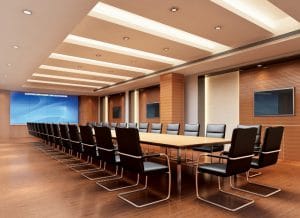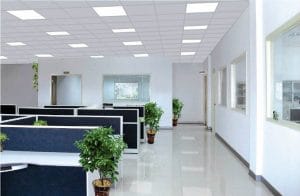 LED lighting technology is revolutionising the illumination market, thanks to its outstanding efficiency. Although LEDs have been around for a few years, it’s only recently that their prices have dropped enough to make a real impact on the market, encouraging many offices to invest in switching to a greener, safer and more energy efficient lighting model while achieving huge savings in their energy bills.
LED lighting technology is revolutionising the illumination market, thanks to its outstanding efficiency. Although LEDs have been around for a few years, it’s only recently that their prices have dropped enough to make a real impact on the market, encouraging many offices to invest in switching to a greener, safer and more energy efficient lighting model while achieving huge savings in their energy bills.
By Baishakhi Dutta
The Philips’ website showcases HCL’s experience of creating its first green building. Reducing energy consumption for the whole building was a challenge. The company was looking for low density lighting throughout the building, including outdoor areas, so that it could save enough energy to get LEED certification. Philips proved to be the perfect lighting partner to help HCL achieve this goal.
There are other well-known examples of companies treading the green path. Cognizant (Bengaluru) wanted to build its new office in a cost-effective and sustainable manner, and hence opted for an LED lighting solution that was more energy efficient, flexible and offered an enhanced light output.
Why switch to LED lighting in offices?
- To reduce lighting bills by up to 90 per cent: LEDs are 20 times more energy efficient than incandescent bulbs. They only need a fraction of the energy to produce the same amount of light. In a short span of time, LED lighting can save a considerable amount of money for companies of all sizes, and since LED bulbs last for so long, the savings will only keep adding up each year.
- To get a fast return on investment: The savings on the electricity bill alone will quickly cover the initial investment, with 2.5 years being the average payback period.
- To minimise the impact of increasing energy rates: Electricity prices have risen considerably in the past few years, but experts predict that they could rise even more dramatically in the future due to the increasing demand and low resources, going from 15p to 25p per unit.
- To reduce maintenance costs: One need not worry about replacing lamps for a very long time because LED lamps have a life span of about 20 years and are more resistant to vibrations and shocks, which makes them more durable and difficult to break.
Save on your electricity bill!
- Remote phosphor LED downlights save 50 per cent of energy, compared to CFL downlights.
- LED accent lighting solutions offer 80 per cent energy savings when compared to halogen spotlights
Latest market trends
Apart from providing an attractive ambience for executive offices through modern designs, LED luminaires are also able to demarcate purpose-specific areas when coupled with intelligent light control systems—for instance, separating working areas from meeting areas based on lighting.
Energy efficiency, perfect illuminance and good colour reproduction are other benefits that ensure LED lighting remains in demand.
“Office lighting is centred around providing a harmonious atmosphere to lessen the stress of working in high activity environments. Known as human-centric lighting, care is taken to address certain important factors such as glare, colour temperature, automated or remote controls, etc,” says Vimal Soni, director, Corvi LED Light.
“The latest market trends in LED office lighting are for cheaper products without any concern about power consumption,” informs Rajeev K. Rohtagi, director, Binay Opto Electronics Pvt Ltd. He adds, “As you are aware, in terms of power consumption, the greater the current, the higher the electricity consumption. However, in LED lighting, greater power consumption does not necessarily mean higher brightness. When considering LED luminaires, it is necessary to focus on lumen output, rather than high power consumption.”
“LEDs have moved one step ahead and now come with smart and connected lighting systems, which means that every frequency of the LED is controllable. The first advantage of using such lights is the flexibility to modulate and manage the light. Second, smart connected lighting has integrated sensors to measure things like temperature, vibration, quality and occupancy. Lastly, by simply adding a communication chip-on-board, these lights can perform remote diagnostics and analytics,” mentions Harshavardhan Chitale, vice chairman and managing director, Philips Lighting India.
“600mm troffers or panels are the most preferred choices, based on legacy designs, with a 5cm tubelight as the light source. LEDs no longer have dimension constraints. The heat sink housing uses minimal metal, and the LEDs soldered on flexible strips add up to a low cost configuration. Smaller downlights are available with a cast overbody or slim form or, in the case of low cost models, in sheet metal or plastic domes. The LEDs are either mounted in full-sized MCPCB or in low-cost thin MCPCB strips. Availability of T5/T8 LED tubes of 18W at lower costs have also promoted wider usage in office spaces,” states Vijay Kumar Gupta, CEO, Kwality Photonics.
“Earlier, there were louvred fittings that created a cave effect and became the norm in commercial spaces and offices. But technology has changed a lot since the 1980s, as has the way we work. The most recent guideline for workplace lighting focuses on the people—on employees who need the lights the most, and are present under them for most of their day. New LED applications offer the freedom from louvres and add a touch of quirkiness to the way these places look now,” says Rambo Zhang, India head, Opple Lighting.
He adds, “Controls are a major topic of discussion these days. The rise of controls has come hand in hand with the rise of LEDs, which can be dimmed and have the ability to send and receive data. Improvements in user interfaces, and the ubiquity of smartphones and tablets, are also helping. With the rise of wireless controls and power-line communication, it’s no longer a task to add controls to an existing building.”
 Suggestions to large institutional buyers
Suggestions to large institutional buyers
“Legacy and price should not determine the purchase decision. One should begin by understanding lumens per watt efficacy, the form factor of the product and warranties for lifetime value appreciation,” says Soni of Corvi.
“LED lights make office workers more productive. This is because certain frequencies of light make them more alert, as light has a direct impact on the hormonal activities of the human body and can suppress the hormones that make one feel drowsy. Institutional buyers need to keep this in mind and select lights accordingly, which in turn will increase productivity,” says Chitale
Rohtagi suggests buyers look at reducing every watt to reduce power consumption. On a standard commercial rate of ₹ 10 per KwH, every single watt of power reduced saves ₹ 85 per year, assuming 24×7 power consumption.
Zhang of Opple Lighting, opines, “Trendy is the new mantra. Large institutional buyers should keep in mind the important features and trends that will help them create a perfect ambience for their workplace. The market in India is very vast and offers different products, which suit almost all the major requirements of the consumers. Indian consumers have this mindset of getting high quality products at a comparatively low price.” He adds that Opple is currently working on reaching the untapped markets.
What the future holds
“The future has already arrived, and stakeholders should embrace it by selecting LED lights that are high in efficiency through higher lumens per watt. We are an energy deficit country and all of us need to contribute by saving energy,” comments Soni.
“LEDs could take over office lighting completely, provided users are not disillusioned by the cheaper quality products available in the market nowadays,” says Rohtagi, adding that prices are being reduced not by increasing production, but by lowering the quality standards. “If LED lamp failures take place before the ROI is achieved, then the existing conventional solutions will appear cheaper,” he says.
“LED lighting will be the default in office lighting, with enhanced functionalities like LiFi communication, mood lighting, dimmability and finally, IoT connectivity,” adds Gupta.
“LED bulbs were costly in the beginning, but over time and with development in technology they have become cheaper. Governments are encouraging people to cut their energy consumption by using these bulbs and thus contribute towards a sustainable environment. Conservation of energy is one major result that these LED light companies are looking forward to. They keep on creating new and innovative lights that are suitable for the Indian consumer and are pocket-friendly. These LEDs consume less energy, are pocket-friendly and really contribute towards sustainability. Over the last few years, the use of LED bulbs and streetlights has shot up in homes, offices and on the roads —all over the world, says Zhang.
Checklist for making a purchase
Suggestions from industry veterans have helped us compile a list of the crucial factors that are to be kept in mind while investing in LED lighting for offices. These are:
- Driverless options for a longer life of the complete system.
- Dimming options for greater power saving.
- Controlling the glare level.
- Higher CRI (>92).
- Good heat sinking of the luminaire.
- A minimum warranty of five years on a 24×7 operating basis – warranty should not be just for failure, but also for L70 light output. Besides, suppliers should be able to showcase previous projects that have exceeded the offered warranty period.
- Efficiency, or lumens per watt, which can be easily derived by dividing the total lumens by the total watts of the luminaire.





























